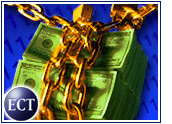
With the books closed on the first quarter of 2003, two business software markers have warned that their results will come in below expectations. Meanwhile, research firm IDC said continuing uncertainty has prompted it to lower its IT spending forecast for the year.
The warnings came from database software maker Sybase, which said second-quarter revenue will total US$180 million to $185 million — at least $20 million below earlier estimates — and PeopleSoft, which said license revenue will fall nearly 40 percent short of earlier forecasts.
PeopleSoft CEO Craig Conway blamed fears over the war with Iraq and continued uncertainty about the economy for the shortfall. “The result was delays in corporate purchasing worldwide,” he said.
Big Picture Fuzzy
Taking a bigger-picture view, IDC now says worldwide IT spending will grow 2.3 percent over last year to $852 billion, with modest growth of 1.5 percent in the United States and declines in some other markets, including Japan.
In December, the Framingham, Massachusetts-based research firm called for growth of 3.7 percent. The new forecast assumes “a relatively short war in Iraq and stability in other regional economies.”
“The outlook for the next six months continues to be extremely volatile, and a double-dip IT recession can’t be ruled out in a worst-case scenario,” said Stephen Minton, director of IDC’s Worldwide IT Markets group. “Once the fog of war has cleared, there will be a gradual recovery in corporate profits and business confidence, and this will translate into increased IT spending.”
Slower-Growth Era
IDC research manager Ned May told the E-Commerce Times that the expected recovery in tech spending may likely start during 2003, but probably not early enough to substantially lift the sector. The firm, he noted, had predicted the rebound to begin this spring, but first uncertainty and then the actual war with Iraq changed that.
In 2003, hardware spending will decline slightly, according to IDC, while software will see 4.5 percent growth and services will rise by 3.7 percent. An eventual recovery, with growth as strong as 6 percent next year, will be driven by proliferation of mobile devices, better integration of enterprise software solutions and growth in the outsourcing arena.
“We still feel reasonably confident there won’t be slippage back into flat or no growth,” May said, noting that some enterprises will be forced into updating aging equipment even without an economic upswing. “The one thing we feel even more comfortable about is that we’re not going to see double-digit growth returning.”
Minton agreed. “Those days have gone, at least until the next paradigm shift or speculative bubble,” he said. “But we will recover to an industry which modestly outpaces growth in the rest of the economy.”
Competing Theories
While acknowledging that the first quarter often sets the tone for full-year results, Morningstar.com analyst David Kathman told the E-Commerce Times that some industry watchers believe pent-up demand exists for technology, which may lead to a recovery before the end of the year.
“The thinking is that the end of the war will release some of that demand,” he said. But there also is increasing concern that even with war fears removed from the equation, the economy will stay soft. “Worries about the war got blamed for a lot of the bad news, but there may be more to it.”
Preaching Patience
IDC remains bullish on IT over the long run and now pegs 2004 for a strong recovery. By 2006, the firm says, IT spending worldwide will top the $1 trillion level.
Previously, IDC lowered its forecast for 2003 PC sales, citing government budget crunches that will pinch sales to schools and colleges.














































Social Media
See all Social Media